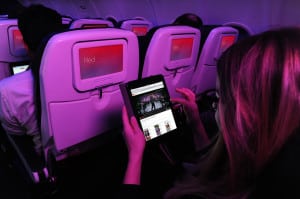[Via Satellite 07-13-2015] ViaSat has entered a technology partnership with Virgin America to provide satellite connectivity for 10 new A320 aircraft through its new hybrid Ku/Ka-band antenna. The first aircraft to use ViaSat connectivity is scheduled to take flight in the continental U.S. in September this year.
Virgin America, formed in 2007, has a 53-aircraft fleet and has provided access to Wi-Fi on all flights since 2009. Last year the airline upgraded to Gogo’s latest generation Air-to-Ground (ATG) technology, ATG-4. Abby Lunardini, vice president of communications at Virgin America, told Via Satellite that the airline chose ViaSat to stay ahead of passenger’s climbing demand for greater throughput.
“Our focus is really on offering travellers a better experience, and connectivity is key. Consumers are using more and more bandwidth, and demanding more and more bandwidth. We wanted to be in front of that and be investing in the next generation,” she said.
ViaSat flew its hybrid satellite antenna on a private government aircraft last year. Don Buchman, vice president and general manager of ViaSat’s commercial mobility business, told Via Satellite that the antenna will fly on another government aircraft later this year. Virgin America is the first commercial airline to use the antenna, which ViaSat has been developing for approximately two years.
“We saw the market coming on, and right when we launched our aeronautical Ka service on ViaSat 1 we immediately took that antenna and started turning it into the Ku/Ka antenna because there was a lot of demand for that coverage,” he said.
Virgin America passengers using the hybrid antenna will leverage Ka-band capacity from the ViaSat 1 High Throughput Satellite (HTS), and Ku-band capacity from ViaSat’s Yonder network. Buchman said there are approximately 500 aircraft that use the Yonder Ku network today, along with thousands of maritime vessels. When available, passengers will receive 12 Mbps in Ka band, and a lesser amount in Ku. Through ViaSat, Virgin America will be able to offer broadband to new Hawaiian destinations beginning in 2016. When the next generation ViaSat 2 spacecraft is launched, ViaSat could service even more flight routes for the airline.
“[ViaSat 2 is] extending that high capacity footprint that today is just over the United States. Now you will get it over Canada, the flight tracks over the North Atlantic into Europe and, for Virgin especially, it will be the routes into Mexico and the Caribbean,” added Buchman.
Virgin America is currently offering Wi-Fi through ViaSat for free, and plans to introduce pricing in 2016.
“Because it is a new service on Virgin and because it will only be rolling out initially to one aircraft in September and then one aircraft a month thereafter, we thought that the best way to approach it would be to have a beta launch period where travellers could test out the product and we can see how they interact with it,” said Lunardini.
She added that the average user rate among passengers tends to be fairly high, thanks to accessibility and the clientele that prefer to fly with the airline. Because Virgin America is located in Silicon Valley, Calif., she said many passengers are focused on staying connected all the time, and this is made easier by having power outlets available at every seat. Lunardini said the average use across the fleet is 18 to 20 percent at any given time. The variance is greatly influenced by the type of flight, with short haul seeing less use, and long haul regularly seeing usage rates above 33 percent.
ViaSat’s Ku- and Ka-band network covers 85 percent of the most regularly travelled air routes in the world. Virgin America has not made a technology decision regarding the rest of its fleet or for future orders, but Lunardini said the airline is evaluating this very closely.
The post ViaSat, Virgin America Explain Ku/Ka IFC Partnership appeared first on Via Satellite.
http://www.satellitetoday.com/telecom/2015/07/13/viasat-virgin-america-explain-kuka-ifc-partnership/
